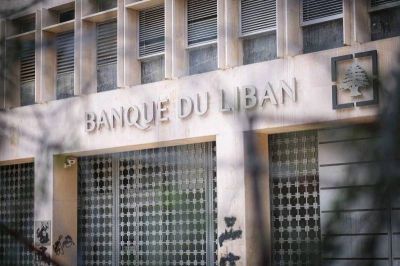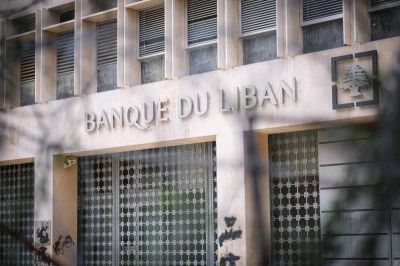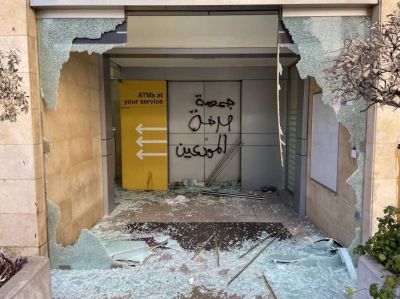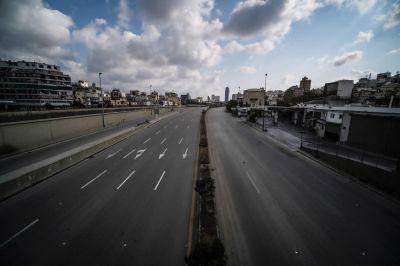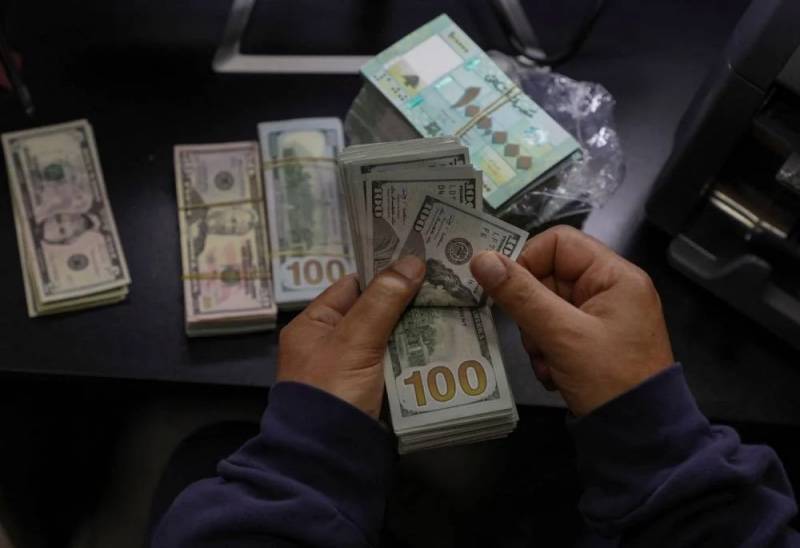
A money changer in Beirut on Jan. 19, 2023. (Credit: Mohamed Azakir/File Photo/Reuters)
This article is part two of a two-part series on how Lebanon’s new taxation system is set to deepen existing inequalities. Read part one here.
BEIRUT — With Lebanon’s new salary and wage tax system in place following the 2022 budget, “any tax has become a regressive tax,” Iskandar Boustany, an economist and budget expert at the Institut des Finances Basil Fuleihan says.
Those who earn salaries and wages in dollars are taxed in lira at an exchange rate of LL15,000 to the US dollar, far below the parallel market rate of LL79,750 as of Monday morning. This in effect gives them a discount on tax payments — one that lira earners do not benefit from.
In a report completed in November, the IMF warned the Lebanese government against setting an exchange rate other than the market rate for tax purposes. But the government, after initially deciding to use the central bank’s Sayrafa rate for tax purposes, has retreated to the LL15,000 rate as of January. LL15,000 is the new official exchange rate as of Feb 1.
Setting tax policy via non-market exchange rates is not advisable, the IMF says, but that policy goes to the heart of financially navigating Lebanon’s multiple rates amid the economic crisis.
Getting here
The story starts in December 2020, with Decision No. 893, which determined that all assets and liabilities acquired in foreign currency were to be recorded at “the actual value of the operation on the date of obtaining those assets” or incurring the liabilities. Foreign currency revenues are similarly recorded “at their actual value in Lebanese lira.”
According to a tax accountant at a major international tax advisory firm, the decision didn’t clarify what the “actual value” was, and so some accountants interpreted it as being the Sayrafa rate and others as the parallel market rate. Some companies, notably multinationals, said there is no actual value other than the one officially published by the central bank: LL1,507.5. The accountant requested anonymity as they were not authorized by their company to speak to the media.
In July 2021, according to an employee of the salary and wage tax department at the Ministry of Finance, a circular was issued by the director of the revenue directorate saying that salaries and wages in foreign currencies were to be recorded at the “market rate.”
The circular, shared with L’Orient Today, states that “whereas those wage earners who receive their wages in foreign currency have obtained the equivalent in the [Lebanese] national currency based on the actual value of the US dollar…and in order to ensure the principles of justice and equality among taxpayers; it is important for the revenue directorate to inform employers that if wages are paid to their workers in whole or in part in US dollars… the value of wages in the national currency must be calculated on the basis of the actual value of the US dollar … against the national currency.” That is, that the value of those wages be calculated at the parallel market rate.
“So we operated under this circular, some people abided by it, some people didn’t, not everyone abided by it,” the employee said.
Enter the 2022 budget. In the days following the budget’s entrance into effect on Nov. 15, the Ministry of Finance issued two decisions, one of which was co-signed by central bank governor Riad Salameh.
Taken together, the measures set the taxable value of cash US dollar income at the rate of BDL’s Sayrafa platform, at the time around LL30,000, a jump from the longstanding LL1,507.5 rate. The decisions raised the taxable income for dollar-earners.
Lebanon lacks accurate data on the percentage of employees who earn their incomes in each currency but a March 2022 AUB survey of households where a member worked in agriculture, construction, education, food and beverage, health care, manufacturing and retail found that fewer than 20 percent of households with a member working in any of the sectors had any access to fresh dollars. The exception was for households with a member who works in health care, where 27 percent had access to fresh dollars. This included fresh dollar remittances, savings and incomes.
Business interest group The Economic Bodies met with the caretaker finance minister and other top government decision-makers, according to the salary and wage tax department employee, and called for the ministry to retract the decisions.
In a December 2022 statement, the organization said “the implementation of these two decisions would completely eliminate the private sector in Lebanon, which is already on the brink of total collapse.”
Then, following a hearing before the parliamentary finance committee, the decisions were frozen. In a statement following the hearing, committee chair Ibrahim Kanaan (Free Patriotic Movement/Metn) said the committee supported “amendment of the [tax] brackets by law and the setting of an acceptable and fair exchange rate not on Sayrafa or anything close to Sayrafa.”
According to the subsequent decision issued by the ministry in January, cash dollars are now to be valued at LL15,000 for tax purposes, less than a fifth of their value on the parallel market as of Monday.
The decree also uses a lower exchange rate — LL8,000 to the dollar — for retroactive tax levies applied to the first 10.5 months of 2022. And domestic bank transfers over $3,000 (in “lollars,” or dollars trapped in Lebanese banks) benefit from the LL8,000 rate for the first $3,000 and then LL1,507.5 thereafter.
In effect, using a lower exchange rate for tax dollars means that the tax rates included in the 2022 budget are far lower and could continue to shrink, but only for dollar earners. Lira earners will pay the full amount of taxes demanded from them.
“This mechanism of course isn’t fair … but this is how the decision came out and we will abide by it,” said the salary and wage tax department employee.
Asked about the tax law’s unequal treatment of lira and dollar earners, Kanaan told L’Orient Today that the matter “was handled exclusively by the minister of finance and his team at the ministry” and said that during committee discussions “we asked the minister to change course for a fairer approach.”
The caretaker finance minister’s office did not respond to questions about the rationale for reversing the decision to use Sayrafa, or whether they disagree with the IMF’s position.
Elie Abi Aad, from the salary and wage tax department of the Finance Ministry, speaking on behalf of the Acting General Director Georges Marawi, told L'Orient Today that the tax exchange rate was to be complemented with tax amendments related to tax brackets and family allowances.
These amendments need a law to enter into force, laws that only the Parliament can vote on. But the current Parliament cannot pass laws before it elects a new president.
This is why, according to Abi Aad, the minister fixed the tax exchange rate to LL15,000 instead of LL30,000. And "now, there is a basket of amendments that are already prepared in order to be in line with the developments related to inflation, dollar rate...etc.," explains Abi Aad.
Boustany said he did not know why the decision was made but that “maybe it was an issue of them being afraid that people would rise up against them if they made a complete tax. But in any case, all sectors have adapted to the rise in the price of the dollar except the public sector. Sooner or later, this will happen, and the longer we delay it, the longer the public sector bears the costs, and the longer the private sector benefits at the expense of the public sector.”
Economist Sami Zoughaib of Lebanese think tank The Policy Initiative said the country’s politicians, and in particular central bank governor Riad Salameh, have consistently tried to set policy by creating and abolishing different lira-dollar exchange rates.
“I think this is a mechanism that has been used and abused since the start of the crisis and that is completely … futile and, secondly, incredibly harmful,” Zoughaib said. He added that exchange rate modifications fall far short of the reforms needed to address structural problems in Lebanon’s economy but are politically expedient for lawmakers in office.
“The thing that they are doing with the exchange rate is the least politically challenging way that they can address things currently,” he said, adding that many political players find an added incentive in their ability to shift blame onto Salameh.
“Imagine what tax reform really means. Nabih Berri would have to tax his people, his cronies, 30 or 40 percent on capital gains and another 30 or 40 percent on income,” Zoughaib said. “They would absolutely obliterate the guy.”
Chaotic accounting practices
The valuation of the dollar far below its exchange rate on the parallel market has pushed companies to perform their accounting in ways that diverge from the economic reality they are facing.
“In my view, all the financial positions of the companies in Lebanon are wrong and do not state fairly the situation,” said a tax accountant at a major international tax advisory firm, who was not authorized by the company to speak to the media.
“Especially when they are reporting their numbers in Lebanese pounds, and that’s why, if you look at any bank, or any company’s financial statements, the auditors are issuing adverse opinions by saying we cannot really give an opinion on those financial statements,” the accountant said.
“What we’ve seen is that in 2021 mainly, a number of companies started doing their accounting based on the LL38,000 or the Sayrafa at that time, but then in 2022 they reverted back to the 1,500 and now they are just accounting for the transactions in foreign currencies using the 15,000. That’s usually the trend that we’re seeing in the market recently.”
But it’s not a simple matter to tell companies simply to use the market rate, for reasons that go beyond Finance Ministry decisions that set artificial values for the dollar. Lebanon’s currency market is highly informal, in ways that make it unattractive to companies, especially multinationals.
“There is no formal platform that gives you what is the actual market rate,” said the accountant. “Usually in countries where there is a fluctuation of the market rate, you go to the central bank website and you get the daily rate. In Lebanon, if you go to the central bank website, it shows the LL15,000 [rate] today.”
On top of that, most multinationals are afraid to use the market rate because the parallel market doesn’t offer adequate documentation for auditors and tax authorities in their home countries.
“So that’s why they cannot use the market rate. They are not using Sayrafa either because most of the multinationals don’t exchange money. If they get [revenue] in fresh, they pay in fresh, they don’t go to third parties or to exchange bureaus … this is not allowed, this is kind of a money laundering or tax evasion because you cannot trace the money anymore,” the accountant added.
“That’s why they are stuck with the official rate.”
For Ziad Bekdache, spokesperson for the Association of Lebanese Industrialists, “Logically, today the exchange rate and the VAT need to be on the base of the dollar, the black market price,” but any tax hikes on businesses increase the difference in prices offered by companies in the legal economy and the illegal economy.
“Any increase in taxes, whether VAT or other, will increase the size of the illegal economy and will increase smuggling,” he said.
Economist Jad Chaaban recently estimated the shadow economy in Lebanon could amount to $10 billion per year, or 50 percent of the value of the official GDP.
“The shadow war economy is therefore taking over the country and dwarfing the role of the state. This could engender significant and irreversible damage on the Lebanese society and its survival,” he wrote.
UPDATE: this article has been updated with additional comments from the Finance Ministry received after publication.
